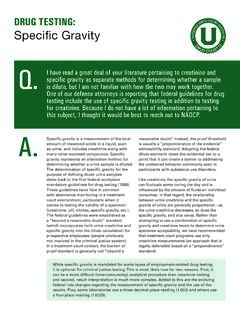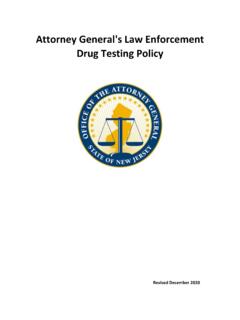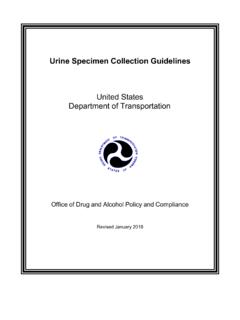Transcription of Clinical Interpretation of Urine Drug Tests - IU
1 Clinical Interpretation of Urine drug Tests : WhatClinicians Need to Know About Urine DrugScreensKaren E. Moeller, PharmD, BCPP; Julie C. Kissack, PharmD, BCPP;Rabia S. Atayee, PharmD, BCPS; and Kelly C. Lee, PharmD, MAS, BCPPA bstractUrine drug testing is frequently used in Clinical , employment, educational, and legal settings and misin-terpretation of test results can result in significant adverse consequences for the individual who is beingtested. Advances in drug testing technology combined with a rise in the number of novel misused sub-stances present challenges to clinicians to appropriately interpret Urine drug test results. Authors searchedPubMed and Google Scholar to identify published literature written in English between 1946 and 2016,usingurine drug test, screen, false-positive, false-negative, abuse,and individual drugs of abuse as key references were also used to identify the relevant literature.
2 In this report, we review technical in-formation related to detection methods of Urine drug Tests that are commonly used and provide anoverview of false-positive/false-negative data for commonly misused substances in the following categories:cannabinoids, central nervous system (CNS) depressants, CNS stimulants, hallucinogens, designer drugs,and herbal drugs of abuse. We also present brief discussions of alcohol and tricyclic antidepressants asrelated to Urine drug Tests , for completeness. The goal of this review was to provide a useful tool forclinicians when interpreting Urine drug test results and making appropriate Clinical decisions on the basisof the information presented. 2016 Mayo Foundation for Medical Education and ResearchnMayo Clin Proc. 2017;92(5):774-796 There have been increased concernsregarding the nonmedical use of pre-scribed drugs and rising trends inillicit drug use and dependence.
3 In 2014, itwas estimated that 27 million Americansaged 12 years and older (representing the population) have used illicit drugs inthe past month; this is compared with drug testing is routinelyused in Clinical practice to rule outsubstance-induced disorders, confirm medica-tion adherence, and identify substances inoverdose situations. Employers and courtsalso perform drug Tests to screen for illicitdrug use. Despite the widespread use of urinedrug Tests (UDTs), there is little publishedinformation on how to correctly interpret theresults of these Tests . Incorrect interpretationof test results (false-positive or false-negative)can have significant consequences (eg, loss ofjob and incarceration). Unfortunately, thereis evidence that there is a deficiency in clini-cian s knowledge about accurate ,3 Regular use of UDT did notcorrelate with increased knowledge; therefore,the need for clinician education may goal of this review was to provide anupdated guide for clinicians that includesrecent reports of agents that may causefalse-positive results on common UDT immu-noassays.
4 We also expanded information onmarijuana on the basis of recent legislativetrends and included information on syntheticcathinones and cannabinoids. Our ultimategoal was to provide a concise reference thatcan be used in everyday practice by cliniciansto accurately interpret UDT results that lead toappropriate therapeutic SEARCHA uthors searched PubMed and Google Scholarto identify published literature between 1946and 2016, using the following key words: Urine drug test, screen, false-positive, false-nega-tive,andabuse. In addition, individual drugsFrom the University of KansasSchool of Pharmacy, Law-rence, KS ( ); HardingUniversity College of Phar-macy, Searcy, AR ( ); andUCSD Skaggs School ofPharmacy and PharmaceuticalSciences, La Jolla, CA ( , ).REVIEW774 Mayo Clin 2017;92(5):774-796 2016 Mayo Foundation for Medical Education and Researchof abuse discussed in the article were also usedas key words.
5 For completeness, we also iden-tified relevant cited references in the initiallyidentified publications. Publications that dis-cussed urinary testing of substances inhumans or human samples only were OF drug TESTINGDrug testing can be completed on various bio-logical specimens including Urine , blood, hair,saliva, sweat, nails (toe andfinger), and meco-nium. Urine is the most commonly obtainedspecimen for drug testing due to its noninva-sive route and ease of sample parent drug and metabolites may bedetected in Urine specimens and are usuallyin higher concentrations than in blood orserum samples. drug detection times arelonger in Urine (ie, 1 day up to several weeks)than in blood or serum are 2 main types of UDTs, screeningand confirmatory Tests . Initial drug Tests orscreens are performed using immunoassaytechnology and are conducted in the labora-tory or onsite with point-of-care testing (POCT).
6 Immunoassays allow for a large num-ber of specimen screens to be completed andprovide relatively rapid maintypes of immunoassays are available: (1)enzyme-multiplied immunoassay technique,(2) enzyme-linked immunosorbent assay(ELISA), and (3)fluorescence polarizationimmunoassay. In general, immunoassays useantibodies to detect the presence of drugmetabolites or classes of drug metabolites inthe Urine . Unfortunately, immunoassays willdetect substances with similar characteristics,resulting in cross-reactivity leading to false-positive increasing trend, especially in painmanagement clinics and with clinicians treat-ing patients with substance use disorders, isPOCT in the office setting. It allows for imme-diate results onsite, allowing the clinician todiscuss results with the patient in real POCTs should be cleared by the Foodand drug Administration (FDA) and are usu-ally waived by Clinical Laboratory Improve-ment Amendments.
7 Visual analysis of the testresult provides Interpretation of the times, results may be difficult to read (eg,faint color and uncertain color), leading tosubjective addition, POCThas the same limitations as laboratory-basedimmunoassays and results should be usedonly to screen for a substance. Consumerswho purchase POCT kits are cautioned againstinterpreting any positive preliminary resultsand confirmatory testing by a professional initial testing conducted with immuno-assays need to be considered presumptive, andclinicians need to use Clinical judgment,patient history, and collaborative informationto decide whether confirmatory testing isnecessary for optimal patient care. Gas chro-matography/mass spectrometry (GC-MS) isconsidered the criterion standard in confirma-tory testing and can identify specific molecularstructures and quantifies the amount of a drugor substance present in the assessments must be conducted byhighly trained personnel, are time-consumingand costly, and thus are reserved for confirm-ing positive drug screens.
8 Liquid chromatog-raphy/tandem mass spectrometry (LC-MS/MS) offers an alternative to GC-MS for confir-matory testing and may be more testing should always be con-ducted when making legal, forensic, academic,employment, or other decisions that have sig-nificant LevelsCutoff values for UDT define the concentra-tions needed to produce positive results forimmunoassays and confirmation testing onGC-MS or LC-MS/MS. Cutoff levels wereestablished to help minimize false-positiveARTICLE HIGHLIGHTSdImmunoassays have many weaknesses that can result in false-positive and false-negative results. Understanding how tointerpret Urine immunoassays (eg, cutoff values, detection times,and false-positive results) is vital when positive results on immunoassays need confirmatory testing (eg, gas chromatography/mass spectrometry).
9 DTesting for designer drugs (eg, synthetic cathinones and can-nabinoids) is challenging secondary to continual changes drug TESTSMayo Clin 2017;92(5):774-796 especially in workplace drug testing (eg, passive inhalation of marijuana causingpositive results; poppy seeds ingestion causingpositive opiate results). Results lower than theestablished cutoff values are reported as nega-tive. Therefore, a negative result does not indi-cate that a substance is not present, but thatthe concentration was lower than the estab-lished cutoff 1displaysthe federal mandated cutoff levels for theworkplace developed by the Department ofHealth and Human clini-cians should be aware of federal cutoff valuesfor substances of abuse, they should recognizethat the federal cutoff concentrations wereestablished for use in the workplace in whichhigher cutoff concentrations may be necessaryto avoid false-positive , inmedical practice, lower cutoff values may benecessary particularly when testing for medi-cation adherence.
10 Clinical laboratories mayuse cutoff levels that are different from federalguidelines; thus, it is important that practi-tioners are aware of the values when interpret-ing results. In addition, clinicians may need torequest a lower cutoff value to be used tominimize false-negative results; however, thismay increase the rate of false-positive , cutoff values were establishedfor the adult population. Lower cutoff valuesmay be necessary for infants due to a moredilute osmolality tends to reachadult values after age 2 TimesDetection time or window is the amount oftime a drug can be detected in the Urine andstill produce a positive result. To evaluatedetection times of a drug or substance, bothdrug characteristics and patient factors needto be considered. drug characteristics includehalf-life, drug metabolites, drug interactions,dosing intervals, low versus high dosage,chronic versus occasional use, and time oflast ingestion.






